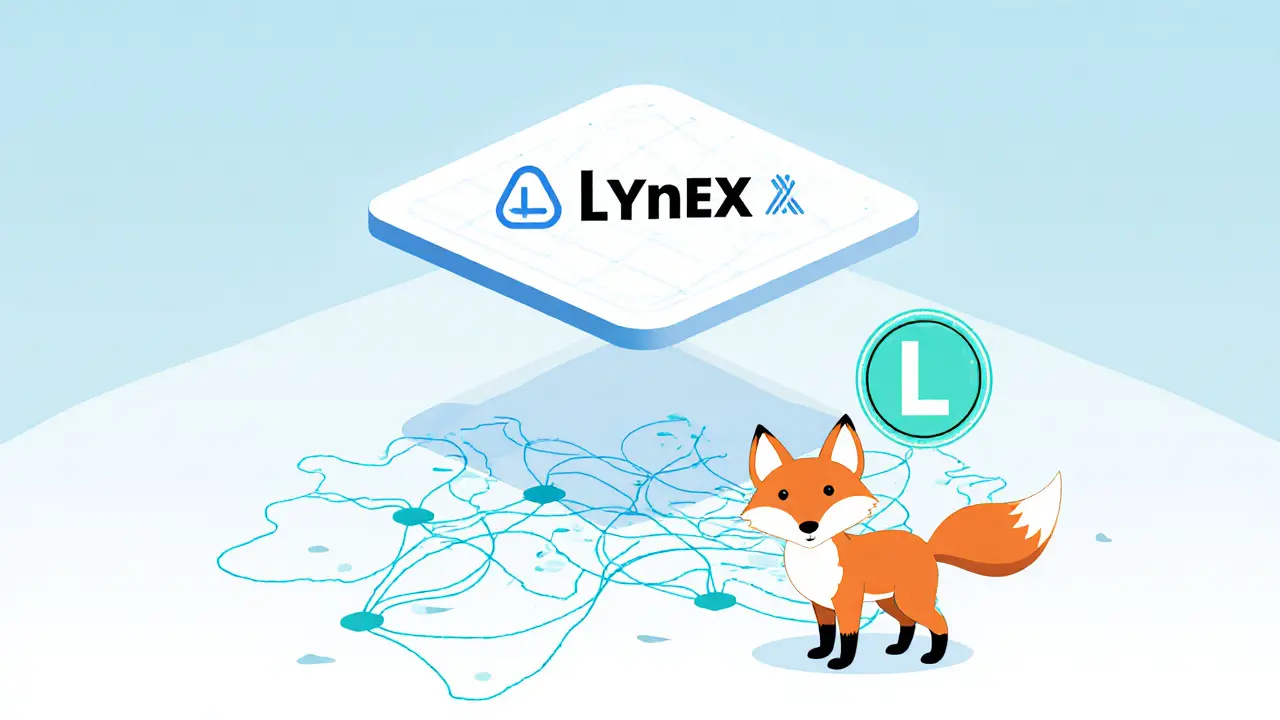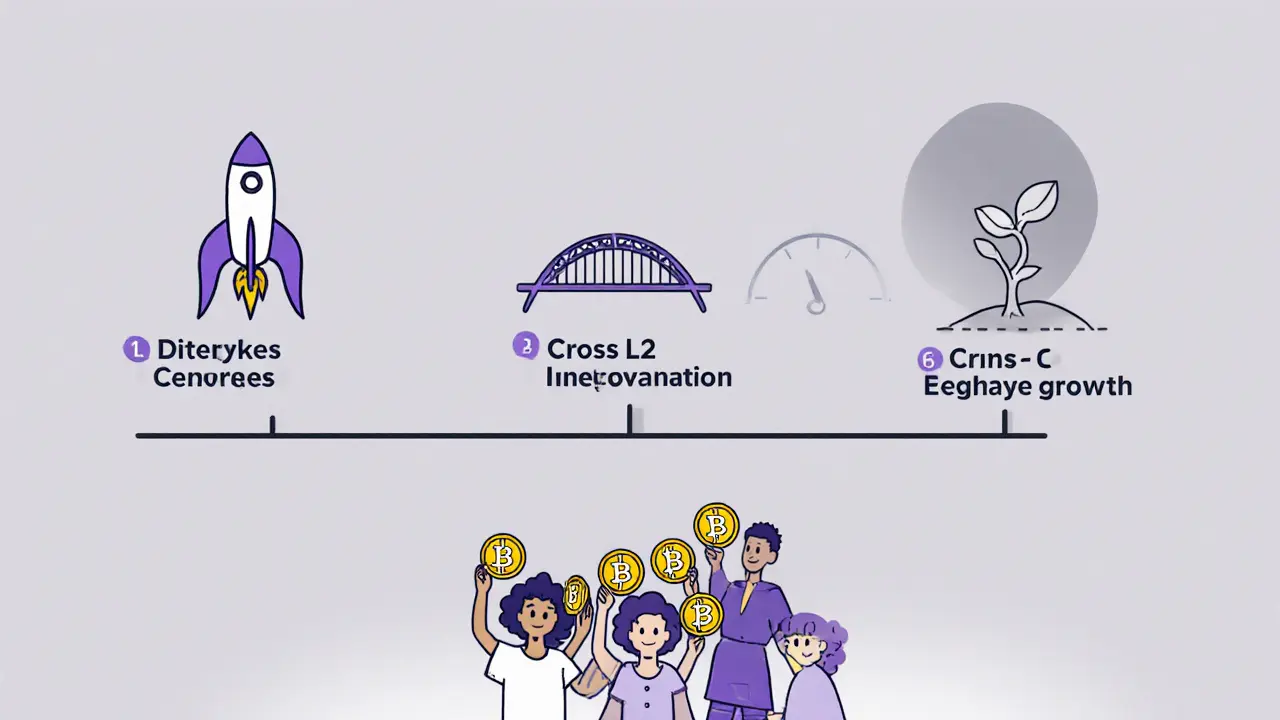Lynex (LYNX) Coin Explained: Features, Tokenomics, and Future Outlook
 Jul, 15 2025
Jul, 15 2025
LYNX Token Emission Calculator
Reward Calculator
Results
Note: Current weekly emission decay rate is 1% per week
Total LYNX supply: 218,828,643 (29.2M circulating)
When exploring new DeFi projects, Lynex (LYNX) is a decentralized exchange (DEX) and liquidity layer built on the Linea blockchain, serving as the native governance and utility token for the platform. Launched in early 2024, the protocol aims to solve liquidity fragmentation on the emerging Ethereum Layer‑2 solution called Linea. If you’re wondering what sets Lynex apart from other DEXs, this guide walks through its core mechanics, tokenomics, market performance, and what you might expect in the next year.
Why Lynex Was Created
The Linea ecosystem grew quickly after ConsenSys introduced its zkEVM scaling technology, but developers soon hit a wall: liquidity was scattered across a handful of generic DEXs, making it hard for new projects to attract traders. Lynex entered the scene with a single mission - provide a native liquidity market that aggregates Automated Liquidity Managers (ALMs) so that everyday traders can tap into expert‑level strategies without writing smart‑contract code.
How the ve(3,3) Model Works
At the heart of Lynex’s economics is a ve(3,3) model. Users lock LYNX tokens for voting power (ve) and, in return, share a portion of protocol fees (the “3”). The third “3” represents a bonus that accrues when both liquidity provision and governance participation align. This design incentivizes long‑term holding because the longer you lock, the more you influence fee distribution and future token emissions.
Token Supply and Emission Schedule
The total supply is capped at 218,828,643 LYNX, with about 29.2 million already circulating (August 2024 data). Emissions start strong - a weekly release that decays by 1 % each week. The weekly decay is meant to soften inflation as the protocol matures, while still feeding liquidity incentives and development funds. Roughly 92 % of all tokens were allocated directly to the community during the initial distribution, a rarity in the DeFi space where founders often keep large portions.
Key Features for Traders and Liquidity Providers
- Concentrated liquidity positions optimized for fee generation and low slippage.
- Marketplace of ALMs where strategies are ranked by historical returns.
- Meta‑transactions on Linea that cost a fraction of Ethereum‑mainnet gas fees.
- Integrations with Chainlink price feeds (added Oct 2025) to guard against oracle manipulation.
For a user who simply wants to earn fees, the UI guides you to pick an ALM, lock your assets, and start collecting a share of the trading fees - typically around a 0.3 % taker fee structure. For power users, the platform provides analytics on fee‑per‑liquidity‑unit, enabling fine‑tuned adjustments.

Comparing Lynex to Other Layer‑2 DEXs
| Feature | Lynex (Linea) | Uniswap V3 (Optimism) | Sushiswap (Arbitrum) |
|---|---|---|---|
| Native Chain | Linea (zkEVM) | Optimism | Arbitrum |
| ALM Marketplace | Yes - every liquidity provider is an ALM | No dedicated marketplace | No |
| Weekly Emission Decay | 1 % decay | None | None |
| 24‑h Volume (Oct 2025) | $45,252 | $1.3 B | $900 M |
| Market Cap (Oct 2025) | $156,395 | $4.8 B | $2.1 B |
While Lynex’s numbers look modest, its niche focus on Linea gives it an advantage for projects already building on that L2. The ALM marketplace is the only real differentiator - it turns liquidity provision into a competitive sport rather than a passive activity.
Real‑World Usage and Community Sentiment
As of October 2025, Lynex hosts around 1,842 unique liquidity providers and 4,287 traders in the last 30 days (Dune Analytics). The token’s price has slipped from an all‑time high of $0.49 to roughly $0.0046, a 99 % decline, which fuels skepticism among investors. Community feedback on Reddit and Trustpilot points to two recurring themes:
- Appreciation for the low transaction fees on Linea.
- Frustration over limited token pairs (only 12 as of Oct 2025) and slow customer support response times.
Sentiment analysis on LunarCrush shows a 62 % negative tilt, mainly driven by low trading volume and perceived lack of growth momentum.
How to Get Started with Lynex
- Install MetaMask and switch the network to Linea (add the RPC endpoint if not listed).
- Bridge assets from Ethereum to Linea using the official Linea Bridge.
- Visit lynex.fi, connect your wallet, and explore the ALM marketplace.
- Select an ALM, approve the token allowance, and confirm the liquidity provision transaction.
- Monitor earned fees in the “My Positions” tab; you can claim them weekly or reinvest.
The whole process takes roughly 2-3 hours for someone familiar with DeFi. The biggest hurdle is the occasional 30‑minute transaction confirmation during peak Linea activity.

Regulatory Landscape
In the EU, the MiCA framework classifies LYNX as a utility token, not a security, which gives projects clearer compliance guidelines. However, U.S. regulators have yet to issue definitive guidance, so participants should stay updated on any classification changes that could affect tax reporting or AML obligations.
Future Roadmap and Risks
Looking ahead, Lynex plans a V2 upgrade in Q1 2026 that will add cross‑AMM arbitrage protection and refined ve‑tokenomics. The roadmap also mentions expanding to additional token pairs and possibly building a bridge to other L2s, a step that could address the current isolation issue.
Financially, the protocol burns about $12,500 per month against reserves of $85,000, giving it roughly a 7‑month runway without new funding. Analysts at Messari argue that if Linea’s total value locked (TVL) grows tenfold by 2026, Lynex could capture 5‑7 % of that niche market, translating to $50‑70 million in annual revenue. Conversely, Delphi Digital notes that niche L2 DEXs have a 68 % failure rate within 18 months, highlighting the importance of user acquisition and volume growth.
Bottom line: Lynex offers a compelling technical stack and community‑first token distribution, but its future hinges on Linea’s ecosystem expansion and the platform’s ability to attract more traders.
Quick Takeaways
- Lynex (LYNX) is a Linea‑based DEX with an ALM marketplace.
- Tokenomics feature a 1 % weekly emission decay and 92 % community allocation.
- Current market cap is $156 k with 24‑hour volume under $50 k.
- Strong niche advantage for Linea projects, but limited liquidity and negative sentiment are major challenges.
- V2 upgrade in early 2026 could improve competitiveness if the Linea ecosystem scales.
What is the primary purpose of Lynex?
Lynex aims to provide a native liquidity market on the Linea blockchain, aggregating Automated Liquidity Managers so that traders can access sophisticated liquidity strategies without writing code.
How does the ve(3,3) model benefit token holders?
Holders who lock LYNX gain voting power and a share of protocol fees. The “3” bonuses reward users who both provide liquidity and participate in governance, encouraging long‑term commitment.
Is Lynex compatible with other Layer‑2 solutions?
Currently Lynex operates exclusively on Linea. A cross‑chain bridge is on the V2 roadmap, but no timeline has been announced.
What are the main risks of investing in LYNX?
Key risks include low trading volume, a small market cap that can amplify price swings, and the platform’s limited runway without additional funding. Regulatory uncertainty in some jurisdictions also adds a layer of risk.
How can I start providing liquidity on Lynex?
Connect a MetaMask wallet to the Linea network, bridge assets, visit lynex.fi, pick an Automated Liquidity Manager, approve token allowances, and confirm the transaction. Fees earned can be claimed weekly.
Matt Zara
October 25, 2025 AT 05:44Lynex is actually kinda cool if you think about it - it’s like the little guy trying to build something real on Linea while everyone else is chasing moonshots. The ALM marketplace is genius for newbies; you don’t need to be a coder to ride the wave of expert strategies. And that 92% community allocation? Rare as hen’s teeth in DeFi. Yeah, volume’s trash right now, but so was Uniswap V1 at first. Give it time.
Also, the decay model? Smart. No pump-and-dump vibes here. Just steady, intentional incentives. If Linea grows even a little, Lynex could be the quiet winner.
Wish more projects had this kind of humility and long-term thinking.
Jean Manel
October 26, 2025 AT 00:33Let’s be real - this is a graveyard token. $156k market cap? $45k volume? You’re telling me this is a ‘project’ and not a dead experiment? The only thing growing here is the number of people who got rug-pulled.
99% drop from $0.49? That’s not a correction, that’s a funeral. And ‘ALM marketplace’? Sounds like a buzzword salad for people too lazy to learn how to use Uniswap properly. Linea’s not even a top 5 L2. This isn’t innovation - it’s desperation dressed up as DeFi.
William P. Barrett
October 26, 2025 AT 15:43There’s something poetic about Lynex - it’s not trying to be the biggest, just the most thoughtful. Most protocols scream for attention with airdrops and influencer shills. Lynex whispers: ‘Here’s how liquidity works, here’s how you earn, here’s how you help shape this.’
The ve(3,3) model isn’t just economics - it’s a social contract. Locking tokens isn’t just staking; it’s saying, ‘I believe in this long enough to lock it up.’ That’s rare. Most DeFi is a casino. This feels more like a cooperative.
Of course, the numbers look bleak. But history’s full of projects that looked dead for years before the tide turned. Ethereum itself was a ghost town for a long time. The question isn’t whether Lynex will succeed - it’s whether we’re willing to nurture something that doesn’t beg for validation.
Cory Munoz
October 27, 2025 AT 12:11Just wanted to say I’ve been using Lynex for a few months now - low volume, yeah, but the fees are dirt cheap and the UI doesn’t crash like other L2 DEXes. I’ve made maybe $3 total in fees, but I’m not here for the moon.
My favorite part? The ALMs are actually ranked by real performance, not hype. I picked one with 3% APY and it’s been steady. No drama.
Support is slow, I get it. They’re a tiny team. But I appreciate they’re not pretending to be Coinbase. Just… quietly building. Keep it real, Lynex team 🙏
Jasmine Neo
October 27, 2025 AT 17:58Stop romanticizing this dumpster fire. This isn’t ‘community-first’ - it’s community-last. 92% allocation? Great, now the whales dumped it and the retail got stuck holding the bag. You think the devs didn’t cash out early? Please. And ‘weekly decay’? That’s just a fancy way to say ‘we’re printing until the money runs out.’
Linea? Nobody’s using it. The only reason this exists is because some VC got bored and threw $2M at a dev who thought ‘zkEVM’ was a magic word. $12.5k monthly burn? That’s a death spiral with a whitepaper. If you’re still holding LYNX, you’re not a believer - you’re a sucker.